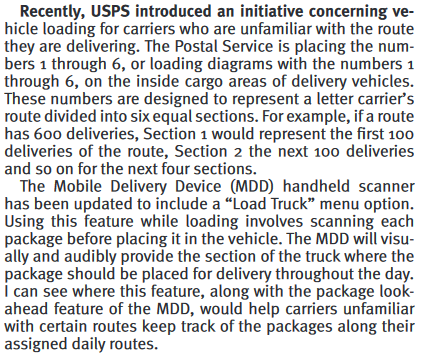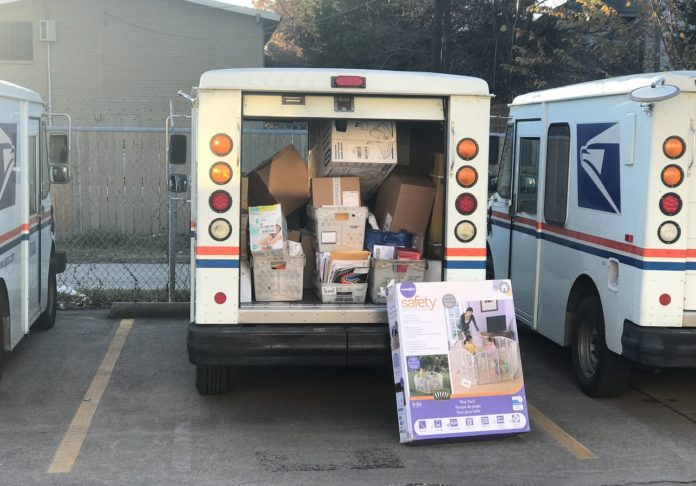City and Rural Carriers on workroom floors and in online forums are expressing much displeasure about a new time-wasting parcel scanning and loading program that has carriers scanning all parcels while loading in order to determine where to place the parcels in the vehicle. The micromanagement routing program divides the back of carrier vehicles (such as LLVs) into six sections (1,2,3,4,5,6). Carriers scan each parcel to be loaded and the scanner provides the section for the parcel to be placed depending on the delivery sequence. Parcels at the beginning of the route are loaded in section 1 while parcels towards the end of the route are loaded in section 6 for example. During delivery, the scanner provides a list of the parcels to be delivered in the correct delivery order. Not only does the new system result in extra workhours and overtime pay, there is also the potential for repetitive motion injuries to the hand doing all the lifting.
Some carriers are suspecting a scanner “desk jockey” with no real world experience in loading vehicles is responsible. Rural carriers, who are paid via an evaluated system, are suspecting the program is somehow designed to take away time from their routes by denying the right to mark parcels. (A Step 4 was initiated by the NRLCA in January 2018 to address this issue.) There’s also a suspicion there is a future plan by the USPS that would have lower-paid PSE’s load carrier vehicles, much like UPS uses lower-paid workers to load UPS delivery trucks. As for rural carriers, many still use privately-owned vehicles, and depending on the make of the vehicle, a six-section system may be out of the question.
The system, though time consuming, does provide a handy tool for carriers unfamiliar with a given route to load their vehicles in a reasonable fashion. However, for most carriers who know their routes, the scanning is simply a waste of time. Carriers familiar with their routes already know their route sequence. In fact they know it better than 1,2,3,4,5,6. Moreover, each route is different and each route must be loaded differently depending on the mix of letters, flats and parcels. My route has at least half of its parcel deliveries at one stop at the end of the route (section 6). But I use sections 1,3 and 5 to make it work.
NALC Director of City Delivery Christopher Jackson commented on the new system in the January 2018 issue of Postal Record, stating it was only for carriers unfamiliar with the route they are delivering (excerpt below).
 Though the system might be useful for carriers new to a route, the system is being forced on all carriers at many locations according to reports and personal experience. Several months ago we were told of the new system in a standup talk at my post office, and the workroom floor about melted down until we were told we didn’t have to use it. But several days ago that changed, and all carriers must now scan all parcels while loading. Few if any carriers who have regular routes are using the six-section loading system. Nevertheless they are going through the motions of this new decree, scanning each parcel just 30 minutes to an hour after the parcels were scanned by the clerks when sorting.
Though the system might be useful for carriers new to a route, the system is being forced on all carriers at many locations according to reports and personal experience. Several months ago we were told of the new system in a standup talk at my post office, and the workroom floor about melted down until we were told we didn’t have to use it. But several days ago that changed, and all carriers must now scan all parcels while loading. Few if any carriers who have regular routes are using the six-section loading system. Nevertheless they are going through the motions of this new decree, scanning each parcel just 30 minutes to an hour after the parcels were scanned by the clerks when sorting.
Unfortunately the new directive will result in extra work hours, overtime pay and potential injuries to the wrist. Instead of using two hands to get multiple parcels out of the parcel gondola at a time, parcels are grabbed individually with one hand (while the other hand holds the scanner). Many heavier or unbalanced parcels should be handled with two hands, but the new system encourages the use of one hand with the potential for strains, sprains and repetitive motion injuries.
And with the deluge of parcels in this “Amazon” age a little extra time with each parcel adds up when multiplied by 50, 75, even 100 parcels on some routes. With this deluge, the loading system is virtually unworkable anyway. Some carriers are commenting they need “Tetris” training instead to load their vehicles!
There may be a method to the madness. There may be some reason USPS has dictated this seemingly time-wasting practice. Perhaps it’s part of the Informed Delivery Service that will allow more timely notifications for when customers can expect their packages. If there is a reason, perhaps it should be shared to assuage the displeasure with the program.

